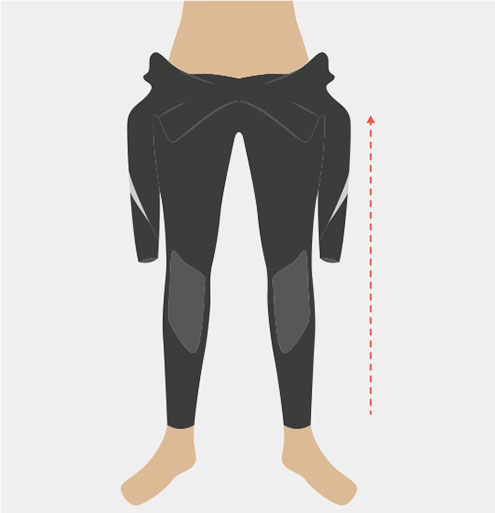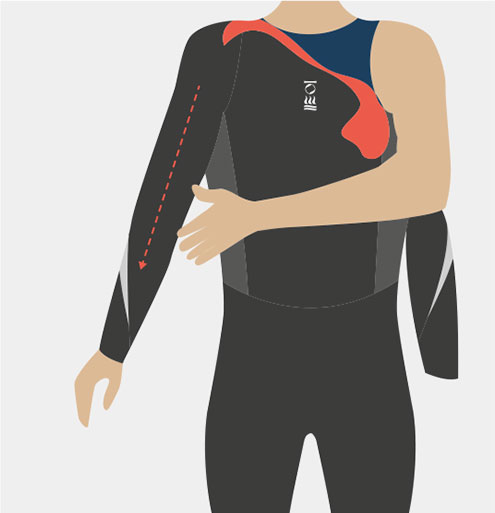Wetsuit Donning Guide

Putting on a wetsuit is sometimes the most exhausting part of the dive, especially with thicker suits for temperate water diving. There is an art to donning a wetsuit correctly to make it easier, plus minimise the risk of your wetsuit being damaged.
Before donning the wetsuit ensure your nails are trimmed and any jewellery is removed to avoid tearing of seals.
Step 1

Step in and once your toes appear through the end of the ankle seal, roll the seal back over your foot until the seal is completely inside out.
Step 2

Carefully put all your fingers inside the rolled ankle seal and ease over the ankle. Leave rolled and repeat for opposite side.
Step 3

Pull the legs right up getting the suit to your waist. You can now roll the ankle seal down or do this last, once entirely in the suit.
Step 4

Ensure the legs are comfortable and untwisted whilst the suit is at your waist.
Step 5

Pull the suit up evenly as far as you can before you put your arms in. Ideally the suit should be right up to your armpits.
Step 6

Put one arm at a time into the suit. Take your time to roll out any wrinkles in the sleeves.
Step 7

If your wetsuit contains a neck seal: Pull the neck seal up and then over your head. Adjust until comfortable, this will ease slightly with use.
Step 8

If your wetsuit contains a neck seal: Tuck in the bib part at the front ensuring it is nice and flat before you zip up.
Step 9

Zip the suit up and adjust the outer collar neck seal for comfort and to reduce water ingress.
Open-Cell Neoprene Wetsuits
Open-cell neoprene wetsuits are delicate in nature. Please use extreme caution when donning and doffing.
Due to the materials and composition of open-cell neoprene wetsuits we have found one drawback to them, which is a susceptibility to tears most commonly occurring when being donned and doffed.
With gentle handling and lots of lubrication when doning, spearfishing and freediving open-cell neoprene wetsuits can be a valued and lasting piece of equipment. Open cell suits require a lubricant to be put on before you slide it on your body. Without plenty of appropriate lubricant, you will not be able to put the wetsuit on without tearing it. We recommend using an eco-friendly suit lube in order to don an open-cell neoprene wetsuit without damaging the inner surfaces.
Divers inexperienced with open-cell neoprene suits often rip and tear the open-cell neoprene, usually with fingernails and toenails, when it is being donned and doffed. Even highly experienced divers can tear open-cell neoprene from time to time. Every time you pull the wetsuit on and off, any cut or tear that it may already have has an increased chance to expand and get worse. Avoid using the wetsuit once you notice any cut or tear.
Because it is so easy to cut the open-cell neoprene of your suit, you should always have some neoprene contact cement in your save-a-dive kit. Purchase some neoprene contact cement, and always follow the repair instructions exactly. There are no shortcuts.
 Gear Aid Aquaseal + NEO Neoprene Contact Cement (44ml)
Gear Aid Aquaseal + NEO Neoprene Contact Cement (44ml)
Our Price: $24
This is simply the best contact cement/glue designed for repairing open-cell neoprene suits. Wetsuit repair is simple and quick with Aquaseal NEO, previously known as McNett Seal Cement. This black flexible liquid adhesive is formulated to permanently bond with neoprene and other coated materials.
See also Wetsuit and Drysuit Repairs.

